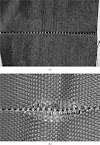Manufacturing Process of Yarn
Yarn is made by strands of staple or filament fibres twisted together to form continuous strand. Further this yarns are woven to create a fabric.
Their are two different methods to produce the yarn –
A. Combed yarn
B. Carded yarn
A. Let’s see process of making combed yarn
1. Ginning
Ginning is a process of removing seeds from cotton. Seedless cotton is then compress together to form a bale (usually weigh 150 Kg).
2. Blowroom
The prepared bale is fed to the blowroom. Here bale is being opened to tuft by removing possible impurities like sand, dust, metal particles, etc. Here bale is converted into small tufts.
3. Carding
The output of blowroom is then fed to the carding where fibre to fibre separation takes place. Here remaining imour8from blowroom is removed. It includes 3 cylinders which having teeth on it used to separate fibres from each other. At the carding creates card lap which is in roll form.
4. Pre comber machine
Pre comber is fed with 8 to 14 card lap (as per requirement) where unwinding is done. After unwinding all the laps are combined together by drafting roller which maintains the weight per unit length and align the fibres in straight direction. Output of pre comber is unilap.
5. Comber
Output of pre comber i.e. unilap is fed to the comber where combing of lap is done. 6 to 8 unilap are fed or as per requirement. Combing process is useful to remove the short fibres from the lap and that’s why it is called comber. It also results in straightening of the fibres. By removing small fibres results in improved quality of yarn. After combing these laps are converted into single card sliver which is output of comber.
6. Draw frame
After combing is done, 6 to 8 carded slivers are fed to the draw frame where drawing of slivers is done. Using drafting rollers the carded slivers are combined together to create evenness in weight per unit length as required. Drawn sliver is the output of draw frame. Drafting rollers also cause aligning of fibres in the straight direction.
7. Speed frame
Drawn slivers are fed to the speed frame machine. Speed frame machine imparts a small false twist using flyers to make engagement of fibres together and crates roving yarns. Upto 24 to 28 drawn slivers can be fed to speed frame to get same number of roving yarns.
8. Ring frame
Output from the speed frame is fed to the ring frame. Here the roving yarns gets the proper twist to gain the required strength and finally wound on the bobbins. Similar to the speed frame, ring frame can be fed with upto 24 to 28 roving yarns to get the similar number of finished yarn. These feeding is depends on the capacity of the machine. Here during spinning on ring frame another type of yarn like spandex can be twist together to get blended yarn.
9. Winding
Bobbins are very small in size and can adopt less amount of yarn. Thus in this process many bobbins are converted into a single cheese or cone by various winding methods. This cone or cheese is then use for the beam preparation.
B. Process for carded yarn
The process for carded yarn is same except the use of pre comber and comber machines. Thus this type of yarns do not have that much quality that combed yarn have. This is because carded yarn includes small fibres which affects the quality of the yarn.
1. Ginning
2. Blowroom
3. Carding
4. Draw frame
5. Speed frame
6. Ring frame
7. Winding














0 Comments
If you have any doubts, please don't hesitate to ask